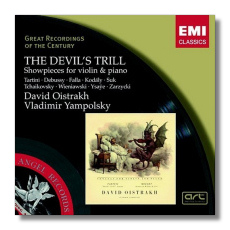
The Internet's Premier Classical Music Source
Related Links
- Latest Reviews
- More Reviews
-
By Composer
-
Collections
DVD & Blu-ray
Books
Concert Reviews
Articles/Interviews
Software
Audio
Search Amazon
Recommended Links
Site News
 CD Review
CD Review
David Oistrakh Plays

Showpieces
- Giuseppe Tartini: Sonata in G minor, Op. 1 #4 "The Devil's Trill"
- Claude Debussy: Clair de lune from Suite bergamasque
- Manuel de Falla: Canciones populares españolas #4 "Jota"
- Eugène Ysaÿe: Extase, Op. 18
- Piotr Ilyitch Tchaikovsky: Valse-Scherzo
- Josef Suk: Love Song, Op. 7 #1
- Zoltán Kodály: Three Hungarian Folk-dances
- Henri Wieniawski: Légende in E Major, Op. 17
- Aleksander Zarzycki: Mazurka in E Major, Op. 26
David Oistrakh, violin
Vladimir Yampolsky, piano
EMI Great Recordings of the Century 5 62915 2 ADD partly monaural 59:35


Serge Prokofieff
- Violin Concerto #1 in D Major, Op. 19
- Violin Concerto #2 in G minor, Op. 63
- Violin Sonata #2 in D Major, Op. 94
David Oistrakh, violin
Vladimir Yampolsky, piano
London Symphony Orchestra/Lovro von Matačić
Philharmonia Orchestra/Alceo Galliera
EMI Great Recordings of the Century 5 62889 2 ADD partly monaural 72:53
Oistrakh's debut outside of the Iron Curtain in the 1950s detonated an explosion in the music world. Everyone was talking about the brawny virtuoso whose Soviet recordings didn't always do justice to his talents; here was a musician who could be mentioned in the same breath as Jascha Heifetz. In some ways, the two violinists were polar opposites. The stereotypes about Heifetz are that he was a consummate technician, albeit emotionally frigid, and often unable to connect with music that was deep – Bach's sonatas and partitas for solo violin, for example. He was all fire and no heat. Oistrakh is supposed to have had plenty of warmth and emotional intensity, but less interest in raising goosebumps with his technical abilities. Of course the truth is not as simple as that, but this comparison will serve to suggest why Oistrakh's first Western appearances were regarded with such interest. Columbia (now Sony) was on hand to record him when he appeared in the United States, whereas his European appearances were used as an opportunity to hustle him in front of microphones belonging to EMI.
The recordings on these two CDs date from between 1954 (Prokofiev's First Violin Concerto, with von Matačić and the London SO) and 1958 (Prokofiev's Second Violin Concerto, this time with Galliera and the Philharmonia). The Showpieces were recorded in 1956 – the Tartini (in Fritz Kreisler's arrangement) comes from a different LP than the rest of the material. (It is the only monaural selection on the CD, which is odd, considering it was recorded only a couple of days earlier)
I wouldn't want to go without either of these discs. Showpieces is dominated by Romantic material, and despite the disc's title, the focus is on introspection and not display. Has any Hungarian ever played the Kodály with such sentiment? One of the wonderful things about Oistrakh was that he resisted the temptation to add unnecessary schmaltz to even the most tantalizing Romantic morsels. Therefore, Wieniawski's haunting Légende isn't sweetened and put through the taffy-puller, as many other violinists have done. Oistrakh's objectivity makes the music that much more moving.
Prokofiev's cool and brilliant First Violin Concerto and Second Violin Sonata would seem to have been tailor-made for Heifetz, but even in these works, Oistrakh makes the listener rethink his or her opinions. Oistrakh's tone is warmer and less wiry, and if the music seems less diabolical, the compensation is that it is more magical and inviting. As is often the case with this violinist, the slow movements are what one remembers the longest after the music has stopped, but that's not to say that the rest of the performances are less than memorable. This is first-class playing all the way, and emotionally generous too. In the Second Violin Concerto, he easily stands above all of the competition, and I think nearly so in the other two works as well. Praise also goes to von Matačić and Galliera, who conduct the concertos with feeling, and for the characterful playing of the respective orchestras. And let me not forget to mention Vladimir Yampolsky, who was a fine pianist with or without Oistrakh, and who partnered the great violinist on many recordings and recitals throughout the 1950s.
These are new digital remasterings of the Prokofieff CD and the Tartini sonata; the rest of Showpieces was remastered in 2002. The sound is excellent throughout, hardly showing its age, even in the monaural material.
Aptly chosen, these are two of the final releases in EMI's "Great Recordings of the Century" series.
Copyright © 2004, Raymond Tuttle



















